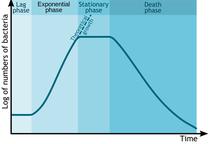 | ||||
Microbial Growth
Practice Test Questions II
Virtual Microbiology Classroom of Science Prof Online
Free review questions to help students better understand this topic.
Microbial Growth Test Questions - Part 2
SPO VIRTUAL CLASSROOMS
 | ||||||
1. A visible cluster of cells that have arisen from one parent cell growing on the surface of a growth medium is called a:
a. bacterium
b. inoculum
c. virulence
d. colony
e. coccus
2. The stage in the population growth curve with the highest rate if cell division is called the ________ phase:
a. stationary b. lab c. log d. enlargement e. death
3. Which term best describes an organism that can exist with or without oxygen?
a. obligate aerobe
b. facilitator aerobe
c. obligate anaerobe
d. facultative anaerobe
e. aerotolerant
4. Which category of microbes would you expect to grow best on or in your body?
a. psychrophiles
b. mesophiles
c. thermophiles
d. hyperthermophiles
5. Microbes that require a level of oxygen slightly lower than that found in the atmosphere surrounding you are called:
a. aerotolerant
b. facultative anaerobes
c. obligate anaerobes
d. microaerophilic
e. aerobes
The following questions, from the Virtual Microbiology Classrooms (8-week & 16-week), are designed to help students better understand this topic. All questions are based on material that can be found on the Microbial Growth Main Page.
Virtual Microbiology Classroom provides a wide range of free educational resources including PowerPoint Lectures, Study Guides, Review Questions and Practice Test Questions.
Page last updated: 2/2016
Time lapse video of bacterial growth on Blood Agar, over the course of one week.
Time lapse video of
E. coli bacteria growing, viewed through microscope.
SCIENCE VIDEOS
6. Which organism has the longest generation time?
a. Escherichia coli
b. Staphylococcus epidermidis
c. Bacillus
d. Mycobacterium
e. Streptococcus pyogenes
7. Which organism would be able to live at the most acidic pH level?
a. Helicobacter pylori
b. Staphylococcus aureus
c. Vibrio cholerae
d. Chlamydomonas nivalis
e. Streptococcus pyogenes
8. Which type of organism would be able to get the most ATP energy from its food?
a. obligate anaerobe
b. obligate aerobe
c. aerotolerant anaerobe
9. The (vegetative cells / endospores) of
Clostridium are killed by exposure to oxygen.
10. Without the help of cholesterol molecules, the phospholipids of the plasma membrane would become more (brittle / fluid) at cold temperatures.
a. brittle 

 b. fluid
b. fluid
Click here for more Microbial Growth Practice Test Questions.
Microbial growth curve. Log phase, followed by exponential phase, stationary phase and death phase.





